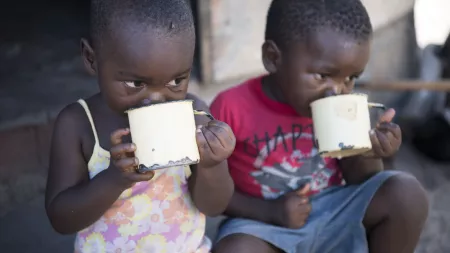LONDON (Dec. 2, 2021)—A group of 120 non-governmental organisations has joined forces in an open letter calling on world leaders to do more to halt a devastating global hunger crisis as new analysis shows the number of people likely to be in need of humanitarian aid in 2022 could rise by 17%.
The Global Humanitarian Overview 2022,1 released today by the United Nations Office for the Coordination of Humanitarian Affairs (OCHA), warned that 274 million people could be in need of humanitarian assistance next year, with the world currently battling the worst hunger crisis this century. This is up from 235 million people in 2021 and 168 million in 2020.
One of the main causes of humanitarian need is food insecurity with the number of people at risk of famine rising 60% since before the COVID-19 pandemic. Currently, an estimated 45 million people across 43 countries are at risk of famine, up from2 27 million in 2019.
CARE joined peer organisations – including nearly 100 locally-based organisations in countries hard-hit by hunger – in an open letter calling on world leaders to fully fund a $41 billion humanitarian hunger response to prevent famine globally and address the emergencies fueling global hunger: conflict, the climate crisis, and the COVID-19 pandemic.
Hunger and malnutrition disproportionately affect women and girls, putting them at increased risk of extreme hunger and gender-based violence. Children are amongst the most at risk- severe malnutrition affects over 45 million children globally, which is the cause of about 45% of deaths of children aged under 5.
Mike Bonke, Action Against Hunger's Country Director in Afghanistan, says:
“In over 15 years working in the aid sector, I can’t remember the humanitarian situation looking so bleak. The threat of famine looms large in several countries and yet it feels like world leaders are watching from the stands.
“In Afghanistan, we already have waiting lists in some of our malnutrition wards and this situation is only going to get worse as winter sets in and food supplies dwindle. The needs on the ground remain astronomical and I predict a very tough winter ahead."
And Tatiana Dasy, Save the Children’s programme director for Madagascar, says:
“In southern Madagascar, the spectre of hunger haunts you everywhere you turn. Parents are surviving on next to nothing and are selling everything they can just to feed their children a portion of sweet potatoes or rice. Sometimes, when they have nothing to eat, families pick leaves and cactus fruit or go to bed without having a meal. On days when children don’t have food on their plates, some of them play a game cooking with sand, soil and leaves, pretending it’s food."
Sally Austin, CARE International, Head of Emergency Operations:
“Famine is currently a very real and terrifying prospect for some 45 million people around the world. And often it is women and girls who are giving up their meals first or facing severe malnutrition during and after pregnancy as they can’t get enough food to feed their babies, not to mention the fact that they face increased risks of gender-based violence and abuse as they try to provide for the family and tensions rise, or walk longer and longer distances in search of food. The latest Global Needs Overview for 2022 has just been released, urgently calling for US$7 billion to support those living with severe levels of food insecurity. Surely, the world can do more to stop people from starving to death.”
Marianne O’Grady - CARE Afghanistan Deputy Country Director
“What’s it like in Afghanistan for millions of people right now? This is what it’s like. They go to bed hungry. They wake up hungry. Everyone in the house wakes up hungry. There’s less and less to feed them. The winter is setting in. Growing food is impossible. Buying food is getting harder, as prices have skyrocketed. Livelihoods have disappeared. Almost 23 million people - more than half the population of Afghanistan - are facing acute hunger this winter. Most of us simply cannot fathom what that is like. Many parents in Afghanistan are being forced to make the most horrific choices to keep their family members alive, and it’s usually the girls who suffer the consequences. We have seen the reports of baby girls being sold so families have money to buy food. Young girls are being married off so there is one less mouth to feed. As an international community, we simply cannot stand back and watch this happen. We must act like lives depend on it, because they do. World leaders must urgently find solutions to allow humanitarians in Afghanistan to operate. Without access to cash, we can simply not respond at the scale required.”
Notes to the Editor:
[1] The Global Humanitarian Overview 2022 report will be available once the embargo on it lifts at 6:00 am CET on Thursday, Dec. 2, 2021 at https://gho.unocha.org/.
[2] Figures reported by the World Food Programme can be found here: https://www.wfp.org/stories/45-million-people-are-famines-door
